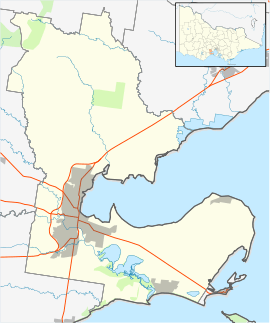St Albans Park, Victoria
St. Albans Park is a residential suburb of Geelong, Victoria, 6 km southeast from Geelong's city centre. It is bounded by Boundary Road (West), Coppards Road (East), Townsend Road (North) and the Barwon River (South). The suburbs that surround it are Whittington, Breakwater, Moolap and Marshall. The suburb extends around the St. Albans Homestead and stud, a historic house and accompanying stables. At the 2016 census, St. Albans Park had a population of 4,843.[1]
| St Albans Park Geelong, Victoria | |||||||||||||||
|---|---|---|---|---|---|---|---|---|---|---|---|---|---|---|---|
 St Albans Park | |||||||||||||||
| Coordinates | 38.167°S 144.363°E | ||||||||||||||
| Population | 4,843 (2016 census)[1] | ||||||||||||||
| Postcode(s) | 3219 | ||||||||||||||
| LGA(s) | City of Greater Geelong | ||||||||||||||
| State electorate(s) | Geelong | ||||||||||||||
| Federal Division(s) | Corio | ||||||||||||||
| |||||||||||||||
The suburb is relatively new, but still contains facilities such as an aged care village, church and many parks and reserves. Due to a significant increase in the number of young families moving to the suburb, a new kindergarten has been built in Homestead Drive. The suburb is close to the Bellarine Village and Newcomb Central shopping centres.
St Albans Uniting Church in Wilsons Road was built in 1869 and dedicated in 1870. Its beginnings can be traced back to forerunner churches and church gatherings from the early 1840s. Forerunner churches and chapels were located in Lakes Road (now Woods Road) in Boronggoop (early name for St. Albans Park area bounded by Barwon River and extending north east in a 10,000-acre (40 km2) allotment - initially held by Caroline Elizabeth Newcomb - to Point Henry), in Hampstead, (early name for St. Albans Park area bounded by Woods / Coppards / Townsend / Wellington Roads), Regent Street and Chapel Street - the last two both in Whittington.
Heritage listed sites
St Albans Park contains a number of heritage listed sites, including:
References
- Australian Bureau of Statistics (27 June 2017). "St Albans (State Suburb)". 2016 Census QuickStats. Retrieved 16 November 2017.

- "St Albans Homestead (H0741)". Victorian Heritage Register. Heritage Victoria. Retrieved 4 July 2014.
- "St Albans Homestead Gate Lodge (H1113)". Victorian Heritage Register. Heritage Victoria. Retrieved 4 July 2014.